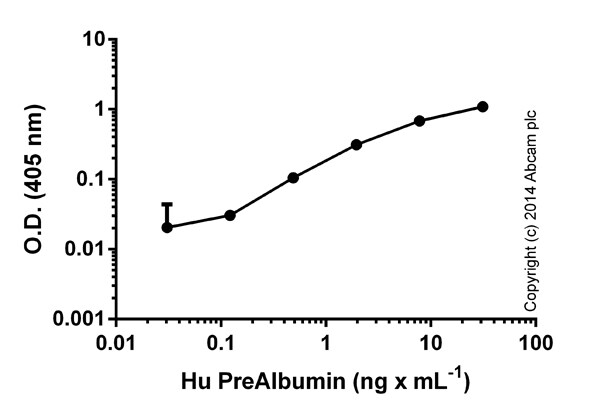Human PreAlbumin ELISA Kit (Transthyretin) (ab108895)
Key features and details
- Sensitivity: 55 pg/ml
- Range: 0.122 ng/ml - 31.25 ng/ml
- Sample type: Cell culture supernatant, Cerebral Spinal Fluid, Milk, Plasma, Saliva, Serum, Urine
- Detection method: Colorimetric
- Assay type: Sandwich (quantitative)
- Reacts with: Human
Overview
-
Product name
Human PreAlbumin ELISA Kit (Transthyretin)
See all Prealbumin kits -
Detection method
Colorimetric -
Precision
Intra-assay Sample n Mean SD CV% Overall 4.3% Inter-assay Sample n Mean SD CV% Overall 9.9% -
Sample type
Cell culture supernatant, Saliva, Milk, Urine, Serum, Plasma, Cerebral Spinal Fluid -
Assay type
Sandwich (quantitative) -
Sensitivity
= 55 pg/ml -
Range
0.122 ng/ml - 31.25 ng/ml -
Recovery
= 98 %
-
Assay time
4h 00m -
Assay duration
Multiple steps standard assay -
Species reactivity
Reacts with: Human -
Product overview
Human PreAlbumin ELISA kit ((Transthyretin) is designed for the quantitative measurement of PreAlbumin concentrations in plasma, serum, urine, saliva, milk, cell culture supernatants and CSF.
A PreAlbumin specific antibody has been precoated onto 96-well plates and blocked. Standards or test samples are added to the wells and subsequently a PreAlbumin specific biotinylated detection antibody is added and then followed by washing with wash buffer. Streptavidin-Peroxidase Conjugate is added and unbound conjugates are washed away with wash buffer. TMB is then used to visualize Streptavidin-Peroxidase enzymatic reaction. TMB is catalyzed by Streptavidin-Peroxidase to produce a blue color product that changes into yellow after adding acidic stop solution. The density of yellow coloration is directly proportional to the amount of PreAlbumin captured in plate.
The entire kit may be stored at -20°C for long term storage before reconstitution - Avoid repeated freeze-thaw cycles.
-
Platform
Microplate
Properties
-
Storage instructions
Store at -20°C. Please refer to protocols. -
Components 1 x 96 tests 100X Streptavidin-Peroxidase Conjugate 1 x 80µl 10X Diluent N Concentrate 1 x 30ml 20X Wash Buffer Concentrate 2 x 30ml 50X Biotinylated Human PreAlbumin Antibody 1 x 120µl Chromogen Substrate 1 x 7ml PreAlbumin Microplate (12 x 8 well strips) 1 unit PreAlbumin Standard 1 vial Sealing Tapes 3 units Stop Solution 1 x 11ml -
Research areas
-
Function
Thyroid hormone-binding protein. Probably transports thyroxine from the bloodstream to the brain. -
Tissue specificity
Detected in serum and cerebrospinal fluid (at protein level). Highly expressed in choroid plexus epithelial cells. Detected in retina pigment epithelium and liver. -
Involvement in disease
Defects in TTR are the cause of amyloidosis transthyretin-related (AMYL-TTR) [MIM:105210]. A hereditary generalized amyloidosis due to transthyretin amyloid deposition. Protein fibrils can form in different tissues leading to amyloid polyneuropathies, amyloidotic cardiomyopathy, carpal tunnel syndrome, systemic senile amyloidosis. The disease includes leptomeningeal amyloidosis that is characterized by primary involvement of the central nervous system. Neuropathologic examination shows amyloid in the walls of leptomeningeal vessels, in pia arachnoid, and subpial deposits. Some patients also develop vitreous amyloid deposition that leads to visual impairment (oculoleptomeningeal amyloidosis). Clinical features include seizures, stroke-like episodes, dementia, psychomotor deterioration, variable amyloid deposition in the vitreous humor.
Defects in TTR are a cause of hyperthyroxinemia dystransthyretinemic euthyroidal (HTDE) [MIM:145680]. It is a condition characterized by elevation of total and free thyroxine in healthy, euthyroid persons without detectable binding protein abnormalities.
Defects in TTR are a cause of carpal tunnel syndrome type 1 (CTS1) [MIM:115430]. It is a condition characterized by entrapment of the median nerve within the carpal tunnel. Symptoms include burning pain and paresthesias involving the ventral surface of the hand and fingers which may radiate proximally. Impairment of sensation in the distribution of the median nerve and thenar muscle atrophy may occur. This condition may be associated with repetitive occupational trauma, wrist injuries, amyloid neuropathies, rheumatoid arthritis. -
Sequence similarities
Belongs to the transthyretin family. -
Domain
Each monomer has two 4-stranded beta sheets and the shape of a prolate ellipsoid. Antiparallel beta-sheet interactions link monomers into dimers. A short loop from each monomer forms the main dimer-dimer interaction. These two pairs of loops separate the opposed, convex beta-sheets of the dimers to form an internal channel. -
Cellular localization
Secreted. Cytoplasm. - Information by UniProt
-
Alternative names
- Amyloid polyneuropathy
- Amyloidosis I
- ATTR
see all -
Database links
- Entrez Gene: 7276 Human
- Omim: 176300 Human
- SwissProt: P02766 Human
- Unigene: 427202 Human
Images
-
Standard curve of Hu PreAlbumin, with background signal subtracted (duplicates; +/- SD).
-
PreAlbumin measured in biological fluids, background signal subtracted (duplicates +/- SD).
-
PreAlbumin detected in cell supernatants, results shown after background signal was subtracted (duplicates +/- SD).
-
Representative Standard Curve using ab108895.















